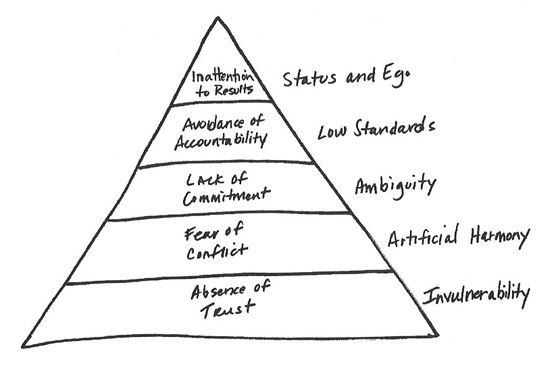What We're Reading Now
Taking Stock of Your Team
16 February 2021
Larissa read The Five Dysfunctions of a Team by Patrick Lencioni, and gained some insight into what might contribute to a team falling short of its goals.
Tags: communication, larissa read, patrick lencioni, reading list, teams
While I know this probably isn’t true for everyone, I’ve never worked at any job that I totally hated. Still, I’ll admit that sometimes I felt really frustrated at work. Even though my coworkers and I would try our best, it often seemed like we were missing benchmarks that were supposed to be easy.
Recently, Rachel recommended reading Patrick Lencioni’s The Five Dysfunctions of a Team. She wasn’t the only person who suggested it to me; this book is actually included in the Allison Partners Reading List. While I knew that the lessons had to be good, I didn’t expect the story to be so engaging. I’m a sucker for mystery novels on the weekend, and even though The Five Dysfunctions of a Team didn’t have quite the drama of a murder mystery, I still found myself totally immersed.

Lencioni opens with a fable about Kathryn, the new CEO of fictional company DecisionTech, as she works to unite the failing company’s otherwise talented and experienced executive team. Many of the characters had flaws that I could see in myself and habits that reminded me of past coworkers. It struck me that many of the situations in the book felt really familiar. As Kathryn and her team uncovered each dysfunction and its root, I felt like I was discovering it too.
For example, the first tier of the model is ‘Absence of Trust,’ which develops from team members feeling uncomfortable sharing their mistakes, weaknesses, or concerns. I wrote in a previous blog about Crucial Conversations: Tools for Talking when Stakes are High, and how Allison Partners created a safe environment for me to share and work through problems as part of a team. In reading The Five Dysfunctions of a Team, I was reminded that I wouldn’t have been so comfortable being vulnerable in my previous workplaces.
As I reflected on my time on other teams, I saw more connections between the difficulties we encountered and the model. In the past, I worked with many people who I thought were really impressive, but I didn’t always feel comfortable telling them when I disagreed. Because of the lack of vulnerability, we didn’t always have productive conflict, and so on and so forth. It can be difficult to identify these problems when you’re in the thick of it, especially because it doesn’t mean that your team members aren’t talented, skilled, or experienced. It doesn’t even mean that they aren’t working hard. However, when one of the dysfunctions exists, it can create a domino effect leading the dysfunctions in the tiers above it to develop.
After the fable is complete, Lencioni shares an assessment to help determine if any of the five dysfunctions could be affecting your team. When I took the assessment, it opened up a dialogue about the way my team works to maintain open communication and share goals. I’m fortunate to be part of a team that has already been practicing good habits, but Lencioni shares some great tools for understanding and overcoming any dysfunctions that you identify. I’d definitely recommend this book to anyone who works with others, especially if you’re sometimes falling short of your goals. Even if you’re working independently now, you might gain some insight into past experiences!







Comments
Our Comment Policy:
Our blog posts are only half of the conversation. What our readers have to say is equally important to us, and we're grateful for all the comments that continue the dialog.
To ensure that the discussion here is as useful as possible to all of our readers, please be respectful of our contributors and refrain from harassing, threatening and/or vulgar language. We reserve the right to screen and remove any comments from the site. If you have a question about a comment or want to discuss our policy, please contact us. We'll talk it over.
There are no comments for this entry yet.